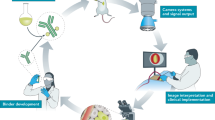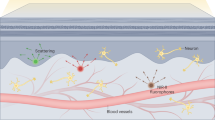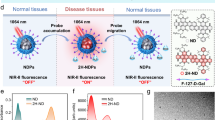Abstract
The second near-infrared wavelength window (NIR-II, 1,000–1,700 nm) enables fluorescence imaging of tissue with enhanced contrast at depths of millimetres and at micrometre-scale resolution. However, the lack of clinically viable NIR-II equipment has hindered the clinical translation of NIR-II imaging. Here, we describe an optical-imaging instrument that integrates a visible multispectral imaging system with the detection of NIR-II and NIR-I (700–900 nm in wavelength) fluorescence (by using the dye indocyanine green) for aiding the fluorescence-guided surgical resection of primary and metastatic liver tumours in 23 patients. We found that, compared with NIR-I imaging, intraoperative NIR-II imaging provided a higher tumour-detection sensitivity (100% versus 90.6%; with 95% confidence intervals of 89.1%–100% and 75.0%–98.0%, respectively), a higher tumour-to-normal-liver-tissue signal ratio (5.33 versus 1.45) and an enhanced tumour-detection rate (56.41% versus 46.15%). We infer that combining the NIR-I/II spectral windows and suitable fluorescence probes might improve image-guided surgery in the clinic.
This is a preview of subscription content, access via your institution
Access options
Access Nature and 54 other Nature Portfolio journals
Get Nature+, our best-value online-access subscription
$29.99 / 30 days
cancel any time
Subscribe to this journal
Receive 12 digital issues and online access to articles
$119.00 per year
only $9.92 per issue
Buy this article
- Purchase on SpringerLink
- Instant access to full article PDF
Prices may be subject to local taxes which are calculated during checkout






Similar content being viewed by others
Data availability
The main data supporting the results in this study are available within the paper and its Supplementary Information. The raw and analysed datasets are available in figshare with the identifier https://doi.org/10.6084/m9.figshare.10316318 (ref. 39).
Code availability
Custom-developed code was applied to overlay the fluorescence signals on photographs. The raw MATLAB codes are available from the corresponding author upon request.
References
James, M. L. & Gambhir, S. S. A molecular imaging primer: modalities, imaging agents, and applications. Physiol. Rev. 92, 897–965 (2012).
Vahrmeijer, A. L., Hutteman, M., van der Vorst, J. R., van de Velde, C. J. & Frangioni, J. V. Image-guided cancer surgery using near-infrared fluorescence. Nat. Rev. Clin. Oncol. 10, 507–518 (2013).
Vinegoni, C. et al. Indocyanine green enables near-infrared fluorescence imaging of lipid-rich, inflamed atherosclerotic plaques. Sci. Transl. Med. 3, 84ra45 (2011).
Choi, H. S. et al. Targeted zwitterionic near-infrared fluorophores for improved optical imaging. Nat. Biotechnol. 31, 148–153 (2013).
Tichauer, K. M. et al. Microscopic lymph node tumor burden quantified by macroscopic dual-tracer molecular imaging. Nat. Med. 20, 1348–1353 (2014).
Pan, Y. et al. Endoscopic molecular imaging of human bladder cancer using a CD47 antibody. Sci. Transl. Med. 6, 260ra148 (2014).
Miller, J. et al. Perfusion-based fluorescence imaging method delineates diverse organs and identifies multifocal tumors using generic near-infrared molecular probes. J. Biophoton. 11, e201700232 (2018).
van Manen, L. et al. A practical guide for the use of indocyanine green and methylene blue in fluorescence-guided abdominal surgery. J. Surg. Oncol. 118, 283–300 (2018).
Tipirneni, K. E. et al. Oncologic procedures amenable to fluorescence-guided surgery. Ann. Surg. 266, 36–47 (2017).
Hutteman, M. et al. Randomized, double-blind comparison of indocyanine green with or without albumin premixing for near-infrared fluorescence imaging of sentinel lymph nodes in breast cancer patients. Breast Cancer Res. Treat. 127, 163–170 (2011).
Gurtner, G. C. et al. Intraoperative laser angiography using the SPY system: review of the literature and recommendations for use. Ann. Surg. Innov. Res. 7, 1 (2013).
Koller, M. et al. Implementation and benchmarking of a novel analytical framework to clinically evaluate tumor-specific fluorescent tracers. Nat. Commun. 9, 3739 (2018).
Van Dam, G. M. et al. Intraoperative tumor-specific fluorescence imaging in ovarian cancer by folate receptor-α targeting: first in-human results. Nat. Med. 17, 1315–1319 (2011).
Burggraaf, J. et al. Detection of colorectal polyps in humans using an intravenously administered fluorescent peptide targeted against c-Met. Nat. Med. 21, 955–961 (2015).
Rosenthal, E. L. et al. Sensitivity and specificity of cetuximab-IRDye800CW to identify regional metastatic disease in head and neck cancer. Clin. Cancer Res. 23, 4744–4752 (2017).
He, S., Song, J., Qu, J. & Cheng, Z. Crucial breakthrough of second near-infrared biological window fluorophores: design and synthesis toward multimodal imaging and theranostics. Chem. Soc. Rev. 47, 4258–4278 (2018).
Hong, G., Antaris, A. L. & Dai, H. Near-infrared fluorophores for biomedical imaging. Nat. Biomed. Eng. 1, 0010 (2017).
Dang, X. et al. Layer-by-layer assembled fluorescent probes in the second near-infrared window for systemic delivery and detection of ovarian cancer. Proc. Natl Acad. Sci. USA 113, 5179–5184 (2016).
Hong, G. et al. Multifunctional in vivo vascular imaging using near-infrared II fluorescence. Nat. Med. 18, 1841–1846 (2012).
Robinson, J. T. et al. In vivo fluorescence imaging in the second near-infrared window with long circulating carbon nanotubes capable of ultrahigh tumor uptake. J. Am. Chem. Soc. 134, 10664–10669 (2012).
Hong, G. et al. Near-infrared II fluorescence for imaging hindlimb vessel regeneration with dynamic tissue perfusion measurement. Circ. Cardiovasc. Imaging 7, 517–525 (2014).
Sun, Y. et al. Novel benzo-bis(1,2,5-thiadiazole) fluorophores for in vivo NIR-II imaging of cancer. Chem. Sci. 7, 6203–6207 (2016).
Zhang, X. D. et al. Traumatic brain injury imaging in the second near-infrared window with a molecular fluorophore. Adv. Mater. 28, 6872–6879 (2016).
Wang, R., Zhou, L., Wang, W., Li, X. & Zhang, F. In vivo gastrointestinal drug-release monitoring through second near-infrared window fluorescent bioimaging with orally delivered microcarriers. Nat. Commun. 8, 14702 (2017).
Cheng, K. et al. Synthesis, characterization, and biomedical applications of a targeted dual-modal near-infrared-II fluorescence and photoacoustic imaging nanoprobe. ACS Nano 11, 12276–12291 (2017).
Wan, H. et al. A bright organic NIR-II nanofluorophore for three-dimensional imaging into biological tissues. Nat. Commun. 9, 1171 (2018).
Antaris, A. L. et al. A small-molecule dye for NIR-II imaging. Nat. Mater. 15, 235–242 (2016).
Sun, Y. et al. Novel bright-emission small-molecule NIR-II fluorophores for in vivo tumor imaging and image-guided surgery. Chem. Sci. 8, 489–3493 (2017).
Sun, Y. et al. Novel dual-function near-infrared II fluorescence and PET probe for tumor delineation and image-guided surgery. Chem. Sci. 9, 2092–2097 (2018).
Antaris, A. L. et al. A high quantum yield molecule-protein complex fluorophore for near-infrared II imaging. Nat. Commun. 8, 15269 (2017).
Carr, J. A. et al. Shortwave infrared fluorescence imaging with the clinically approved near-infrared dye indocyanine green. Proc. Natl Acad. Sci. USA 115, 4465–4470 (2018).
Starosolski, Z. et al. Indocyanine green fluorescence in second near-infrared (NIR-II) window. PLoS ONE 12, e0187563 (2017).
Gotoh, K. et al. A novel image-guided surgery of hepatocellular carcinoma by indocyanine green fluorescence imaging navigation. J. Surg. Oncol. 100, 75–79 (2009).
Ishizawa, T. et al. Real-time identification of liver cancers by using indocyanine green fluorescent imaging. Cancer 115, 2491–2504 (2009).
Morita, Y. et al. Detection of hepatocellular carcinomas with near-infrared fluorescence imaging using indocyanine green: its usefulness and limitation. Int. J. Clin. Oncol. 18, 232–241 (2013).
Ishizawa, T. et al. Mechanistic background and clinical applications of indocyanine green fluorescence imaging of hepatocellular carcinoma. Ann. Surg. Oncol. 21, 440–448 (2014).
Shimada, S., Ohtsubo, S., Ogasawara, K. & Kusano, M. Macro- and microscopic findings of ICG fluorescence in liver tumors. World J. Surg. Oncol. 13, 198 (2015).
Common Terminology Criteria for Adverse Events (CTCAE) Version 5.0 (US Department of Health and Human Services, 2017); https://ctep.cancer.gov/protocolDevelopment/electronic_applications/docs/CTCAE_v5_Quick_Reference_8.5x11.pdf
Hu, Z. et al. Dataset for first-in-human liver tumour surgery guided by multispectral fluorescence imaging in the visible and near-infrared-I/II windows. figshare https://doi.org/10.6084/m9.figshare.10316318 (2019).
Acknowledgements
This study was supported by the National Key Research and Development Program of China (2017YFA0205200, 2016YFC0102600), National Natural Science Foundation of China (NSFC) (81930053, 61622117, 81671759, 81227901), the Chinese Academy of Sciences (GJJSTD20170004), Beijing Natural Science Foundation (JQ19027), Beijing Nova Program (Z181100006218046), the Scientific Instrument Developing Project of the Chinese Academy of Sciences (YZ201672), the innovative research team of high-level local universities in Shanghai, and the Zhuhai High-level Health Personnel Team Project (Zhuhai HLHPTP201703). We acknowledge the instrumental and technical support of the multi-modal biomedical imaging experimental platform, Institute of Automation, Chinese Academy of Sciences.
Author information
Authors and Affiliations
Contributions
J.T., Z.C. and Z.H. conceived the idea of the project. Z.H. wrote the manuscript in addition to designing, performing and analysing all experiments. Z.H., C.F., B.L. and Z.Z. performed the experiments. S.S., P.H. and X.X. collected the information on patients with liver cancer. X. Sun., T.Z. and Y.Z. assisted with histology. Y.C. assisted with PET/CT imaging. C. Cao., M.C., X. Shi., C.L. and C. Chi. assisted with data analysis. Z.C. and S.S.G. assisted with experimental design, manuscript preparation and data/image analysis. J.T. designed, supervised and analysed all experiments, in addition to assisting with manuscript preparation.
Corresponding authors
Ethics declarations
Competing interests
The authors declare no competing interests.
Additional information
Publisher’s note Springer Nature remains neutral with regard to jurisdictional claims in published maps and institutional affiliations.
Supplementary information
Supplementary Information
Supplementary methods, figures and tables.
Rights and permissions
About this article
Cite this article
Hu, Z., Fang, C., Li, B. et al. First-in-human liver-tumour surgery guided by multispectral fluorescence imaging in the visible and near-infrared-I/II windows. Nat Biomed Eng 4, 259–271 (2020). https://doi.org/10.1038/s41551-019-0494-0
Received:
Accepted:
Published:
Issue Date:
DOI: https://doi.org/10.1038/s41551-019-0494-0



